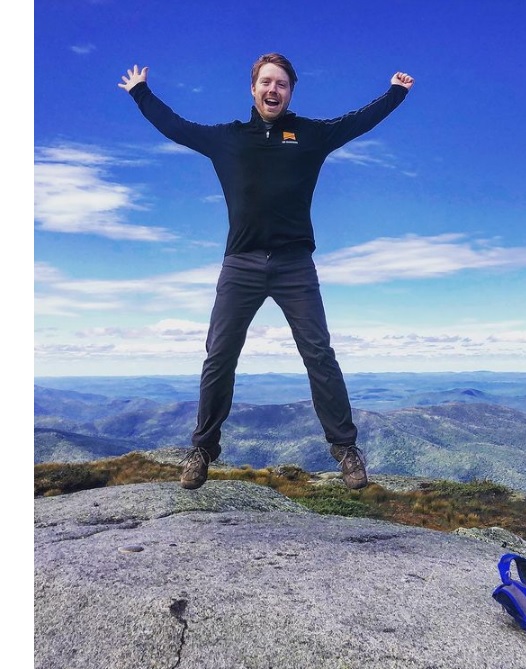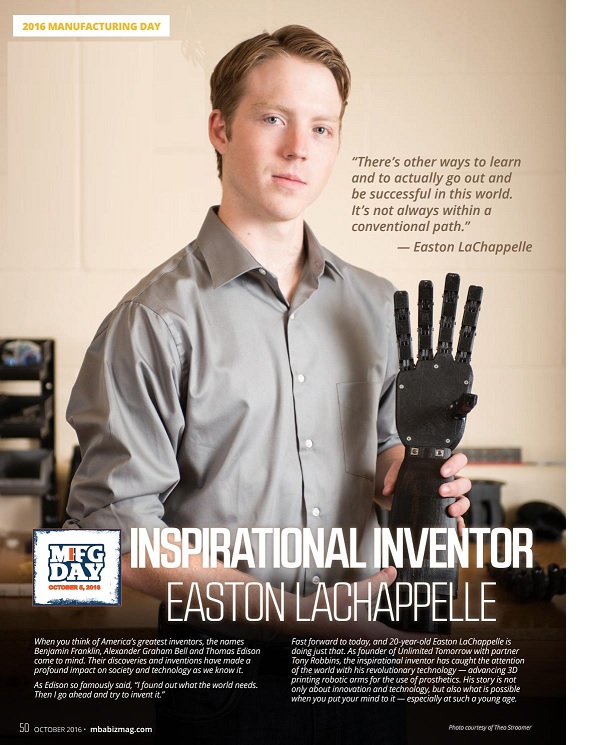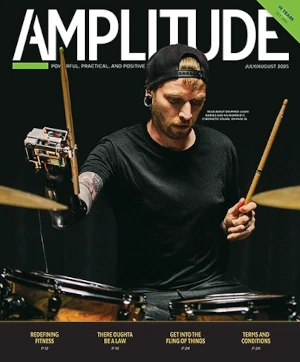
Twenty-four-year-old Easton LaChappelle epitomizes one of the major tech trends we explored in our current issue: the drive toward more affordable, accessible, customer-friendly prosthetic devices. Those are the core objectives of LaChappelle’s company, Unlimited Tomorrow, and his rapid progress has been making headlines and impressing leaders in business, technology, health care, government, and the limb-difference community for over half a decade.
But like any disruptive company, Unlimited Tomorrow has rattled some cages and stirred up some anxieties. Its first product, a bionic arm prosthesis called the TrueLimb, breaks new ground in its design, manufacturing process, consumer-direct sales channel, and pricing model. Is the company introducing too many changes too quickly? LaChappelle thinks not, and he’ll explain why during a live virtual event (which you can attend, and for which you can RSVP here) that Unlimited Tomorrow is hosting next month. The session will include a peek at Unlimited Tomorrow’s design and build shops, some testimonials from early adopters, and preliminary data from studies to measure the TrueLimb’s performance.
We registered for the event, but it’s a month away and we’re impatient. So we talked to LaChappelle last week to learn some more about the state of play in Unlimited Tomorrowland. Our conversation has been edited for length and clarity. Images are courtesy of Easton LaChappelle.
It’s been roughly nine months since the TrueLimb launched. How has the rollout been going?
It was a little nerve-wracking, launching a new product in the middle of a pandemic. We launched back in June of 2020, when COVID was really picking up, and we kind of played around with the idea or postponing and waiting for a better time. Then we realized that, in a lot of ways, that was really the best time to launch. This new remote world we were living in, with telehealth, and telemedicine—our process really fit that bill. So it made a lot of sense for us to launch.
Were there things you had to change on the fly, in terms of supply chain or other adjustments?
A good example of that was our launch video. It was mainly UGC—user-generated content. We didn’t envision launching our product with UGC being the main showcase of our technology. It’s not a bad thing, but it was completely new for us. So it was a matter of communicating back and forth with users and telling them, “Shoot in this style, try to capture these moments.” If COVID hadn’t happened, we would have sent professional video crews to all these locations to capture these incredible moments. But when COVID hit heavy, we saw all these brands leaning into this UGC world. So we did, too. We just had to be creative in going about it.

Luckily, there was nothing too difficult on the supply chain. There wasn’t anything that forced us to rethink the design of the product. We had to rethink our manufacturing a little bit to be within CDC guidelines. And the office staff did go remote—I launched the product literally out of my living room at my house. That’s another one of those things I never imagined would happen like that, but it did. So, some fun challenges along the way.
When you were taking this product from the concept stage to final product design, how did you become aware of this demand for a new approach?
It’s been seven years since I started the company. The reason I started creating prosthetic limbs is because I met a young girl at a science fair who had a very expensive below-elbow prosthetic limb that had taken months to create. And it just blew me away, because at that time I was making these robotic hand devices for a couple hundred dollars. I just thought the technology could be so much better.
I immediately started looking into this and reading the published research studies, and I quickly found the poor adoption rates within the pediatric group. The numbers vary, but I think it’s roughly 40 percent of children reject their prostheses. And that’s just an awful number. We as an industry have to do better there. There are a mixture of things that could deter someone from continuing to use their device for everyday tasks, but it comes down to the weight, the battery life, the aesthetics, and the time commitment for training.
I also started attending an event called the Amputee Long Drive Championship. I’m actually not sure if it’s still around. I’d go there, show some of my technology, spend time around people with limb loss, and find out what they like and what they don’t like about their technology. I interviewed a lot of upper-limb amputees who would talk about specific features—“I wish I could do this,” or “If it only did this,” or “I forgot my charger, so I’m just not gonna wear my arm today.” It was all these little things about day-to-day usage and logistics.
In more of a formal sense, we started to produce surveys and research studies in the last three to four years, and we’ve had a couple hundred responses to help us gauge how we as a company can design the best product. Do people want the robotic superhero device, or do they want something that’s humanlike? Do they want fingernails they can pop on and off? We had some assumptions, but we wanted to validate those. After that research, we started prototyping a more commercialized solution, and then we created a test group where we gave 100 devices to people from every walk of life, age seven to 70something. We extracted as much information as we could from that group to understand what they love, what they hate, and how we can do better.

We’ve heard some concerns about the direct-to-consumer model, and specifically the absence of a prosthetist being involved during the fitting. Are those fair concerns?
We’re a new company, with new technology and a new process. We are disruptive, so there’s gonna be some resistance. We understand that. But whether people think we’re doing something incredible or they think that what we’re doing can’t be done, those reactions mean we’re doing something right. And in a sense, what we’re doing is not that different from what’s already been happening in the industry. Central fab[rication] has caught on like wildfire. 3D scanning of residual limbs is becoming more and more of a norm. All we’re doing is packaging it all up under a single roof. We design the technology, we’re the manufacturer, and we do the fitting process. So we have this incredibly tight feedback loop of everything that’s going on.
I’ll use the analogy of orthodontics. I had wire braces growing up and rubber bands and all that. And then Invisalign came along, where you have scans made in the orthodontist’s office, and the braces are fabricated in a central facility and shipped back to the orthodontist; they pop them in, and you’re off to the races. I think the [prosthetics] industry was almost at the Invisalign stage, and we jumped straight ahead to Smile Direct, where I can just go online, place an order, bite into an impression kit, and get my braces sent to me. So I think we took a couple of big steps into the future.
Would it be accurate to say that Unlimited Tomorrow is moving in a direction the industry was already moving, but you stepped on the accelerator? Maybe you sped things up before people were ready to move that fast?
Yeah, that’s the way I look at it. If people had been able to acclimate—if we’d put some products out over the last couple of years, and people could see the journey that got us where we are today—I don’t think anybody would have looked twice. But we came right out of the gate with a lot of new technology, ultrapersonalization, and a new price point all at the same time. So it’s hard for some people to comprehend how we could get all this done.
There’s always gonna be a little bit of politics surrounding disruption. But we really just care about patient outcomes. If there’s chatter along the way, we hope that ultimately the right people will join our mission and embrace this change. Because we all have the same mission.
Do you feel like some of those alliances are starting to form?
They are. We’re finding a lot of like-minded people who already implement scanning and are thinking outside the box with us. That’s what we hope will happen. It we put our heads together, that’s how we can make a lot happen. I think we’ll see more and more partnership as we get our feet on the ground and start gaining more of a reputation within this industry and as this new wave of technology is embraced.
What are your targets for adoption rates you’d like to achieve with the TrueLimb?
Great question. We have several ongoing research studies to show this industry—and also our future customers—how our technology stacks up. We have an an IRB-approved research study with a small number of cases that we’re evaluating the adoption over over a period of time. We want to be able to prove that the remote fitting process is viable with irrefutable facts: Here are our adoption rates, and here are our patient outcomes. That’s really how we can boil it down so if someone says, “There’s no way you can do [what you promise],” we have a stack of research behind us.
We also do a lot of informal surveys with a lot of our users to solicit general feedback. And we partner with a couple of organizations. One that I really care about is Lucky Fin. They’ve helped distribute some of our surveys so we can gain insight from a wider population that includes non-device users or parents. We have to constantly test our assumptions and make sure that what we’re putting out does work and customer satisfaction is as high as possible. [Lucky Fin also is cosponsoring Unlimited Tomorrow’s virtual event next month.]
So far, 3D-printing has mainly been associated with arm prostheses. Is a 3D-printed, direct-to-consumer prosthetic leg on the horizon?
I’ll address this in a couple of different ways. First, I want to follow through on the TrueLimb in its entirety. I want anybody who needs an upper-limb prosthetic device to have TrueLimb as an option. And we’re still learning a lot. We’re constantly improving it. So that’s something that we we are gonna follow through on completely.
Second, I have really serious reservations about getting into lower extremity, especially with remote 3D printing, just due to the fact that it’s weight bearing. There are so many other variables associated with lower limb that we don’t have to address in any sort of way with with upper extremity. We are suspending versus being weight bearing, and that gives us a bigger margin of error from a design perspective. Now, I have many ideas about different types of joint designs, and I would love to be able to dabble in that in the future. But it’s not something we’re looking at heavily right now.
What’s the ultimate steady state for the prosthetics industry? In 10 or 20 years, do you think we’ll stabilize at a point where the model that has existed for the last 40 years coexists alongside this newer model you’re pioneering? Or will the new model eventually just replace the old one?
Looking that far out, I think it’s all gonna be a model very similar to ours. That’s just the progression of any type of technology and any type of industry. I look at it just from that high-level trend. There’s gonna be a transition period, and we would love to spend that transition period working with certified prosthetists and existing clinics. We want to continue to grow our network, because that’s how we can create that bigger ripple effect of change in patient outcomes. We always want to be on that bleeding edge, but we’re always looking for partnerships and collaborations in all capacities to be able to achieve that.



